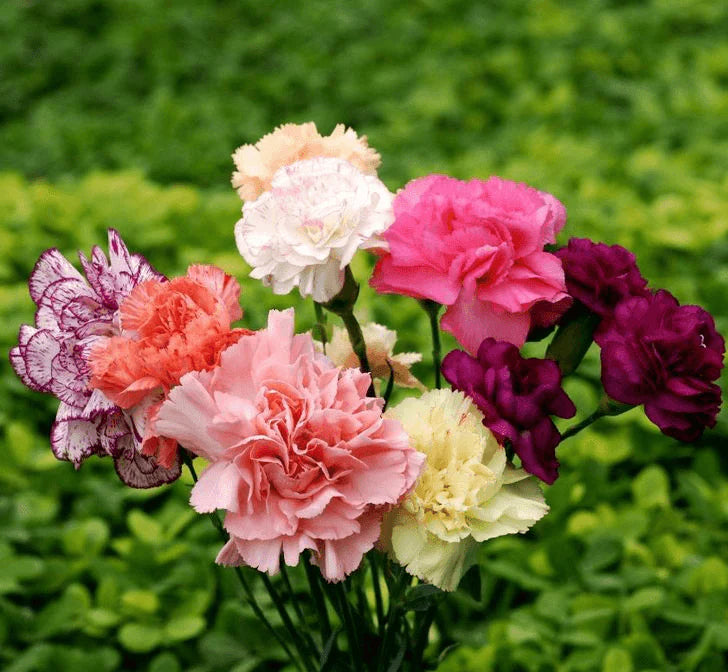
Effective Pest Management in Carnation Cultivation
Share
Introduction
Carnations (Dianthus caryophyllus) are popular ornamental flowers known for their vibrant colors and pleasant fragrance. They are widely used in the floral industry and as garden plants. However, like all plants, carnations are susceptible to various pests that can affect their health and aesthetic value. Effective pest management is essential to ensure healthy growth and highquality blooms. This blog will explore common pests that affect carnations and provide practical strategies for managing them.

Understanding Common Pests in Carnations
Before diving into management strategies, it’s essential to identify the common pests that affect carnations:
Aphids: These small, sap-sucking insects can cause yellowing and curling of leaves, stunted growth, and the spread of viral diseases.

Spider Mites: Tiny pests that cause speckled, yellowish damage on leaves, often leading to webbing and severe defoliation.

Thrips: Small, slender insects that cause silvery or stippled damage on petals and leaves, leading to distorted and discolored flowers.

Leaf Miners: Larvae that create winding tunnels inside the leaves, causing blotchy, transparent patches.

Caterpillars: Larvae of various moths and butterflies that chew holes in leaves and flowers, leading to significant damage.
Whiteflies: Small, white, flying insects that suck sap from the underside of leaves, causing yellowing and weakening of the plant.

Integrated Pest Management (IPM) Approach
An integrated pest management approach is the most sustainable and effective method for managing pests in carnations. This involves a combination of cultural, biological, and chemical controls.
Cultural Controls:
Proper Spacing: Ensure adequate spacing between plants to promote air circulation and reduce the risk of pest infestations and fungal diseases.
Sanitation: Regularly remove and dispose of any plant debris and weeds that can harbor pests. Clean tools and equipment to prevent the spread of pests.
Healthy Soil: Maintain healthy soil through proper fertilization and watering practices to encourage strong, resilient plants.
Biological Controls:
Beneficial Insects: Introduce natural predators like ladybugs, lacewings, and predatory mites that feed on aphids, spider mites, and other pests.
Parasitic Wasps: Use parasitic wasps to control caterpillar and leaf miner populations.
Nematodes: Apply beneficial nematodes to the soil to target soil-dwelling pests like caterpillars and thrips.
Chemical Controls:
Organic Insecticides: Use neem oil, insecticidal soaps, or pyrethrin-based sprays as a first line of defense. These are less harmful to beneficial insects and the environment.

Synthetic Insecticides: If pest pressure is severe, carefully use synthetic insecticides. Always follow label instructions and consider the impact on non-target organisms.
Monitoring and Early Detection
Regular monitoring is crucial for early detection and management of pests.Here are some effective monitoring techniques:
Visual Inspections: Regularly check the undersides of leaves, stems, and flowers for signs of pests or damage.
Sticky Traps: Use yellow or blue sticky traps to monitor for flying pests like whiteflies and thrips.

Magnifying Glass: Use a magnifying glass to spot small pests like spider mites and thrips that may be difficult to see with the naked eye.
Environmental and Preventive Measures
Creating an environment that deters pests can significantly reduce the need for interventions. Some effective measures include:
Mulching: Apply mulch around the base of plants to retain moisture, suppress weeds, and reduce soil-borne pests.

Water Management: Avoid overwatering, as it can create favorable conditions for pests like aphids and spider mites. Water plants early in the day to allow foliage to dry before nightfall.
Companion Planting: Plant carnations alongside pest-repellent plants like marigold, basil, or garlic to naturally deter pests.
Managing Specific Pests
Aphids:
Spray plants with a strong stream of water to dislodge aphids.
Introduce ladybugs or lacewings, which are natural predators of aphids.
Spider Mites:
Increase humidity around the plants, as spider mites thrive in dry conditions.
Use neem oil or insecticidal soap to manage infestations.
Thrips:
Use blue sticky traps to monitor and control thrip populations.
Apply insecticidal soap or neem oil to reduce infestations.
Leaf Miners:
Remove and destroy affected leaves to prevent the spread of leaf miners.
Introduce parasitic wasps that target leaf miner larvae.
Caterpillars:
Handpick caterpillars from plants and dispose of them.
Use Bacillus thuringiensis (Bt), a natural bacterial insecticide, to control caterpillar populations.

Whiteflies:
Use yellow sticky traps to capture and monitor whiteflies.
Apply insecticidal soap or neem oil to manage infestations.
Conclusion
Effective pest management in carnation cultivation requires a holistic approach that integrates cultural, biological, and chemical controls. By understanding common pests, implementing preventive measures, and regularly monitoring the crop, gardeners and growers can maintain healthy carnation plants and achieve high-quality blooms. Remember, the key to successful pest management is early detection and a balanced approach that minimizes environmental impact while effectively controlling pest populations.
By following these strategies, you can ensure your carnations thrive, providing beautiful and fragrant flowers for your garden, home, or business. Happy gardening!
